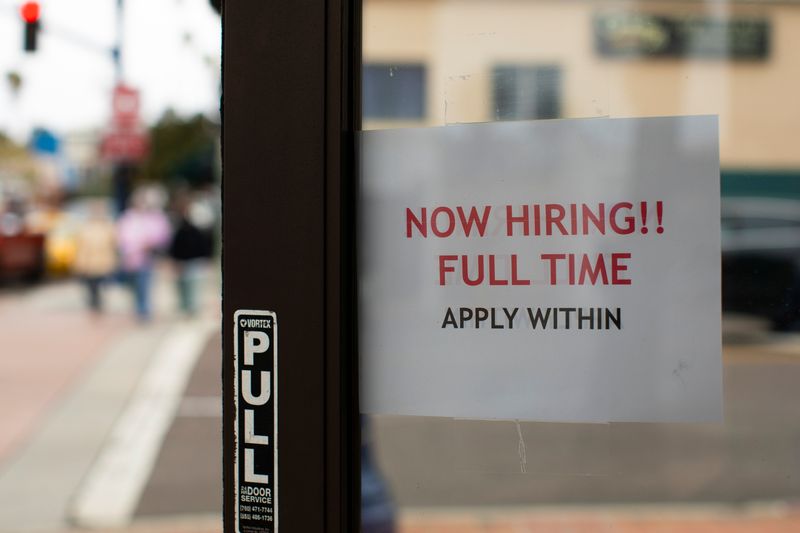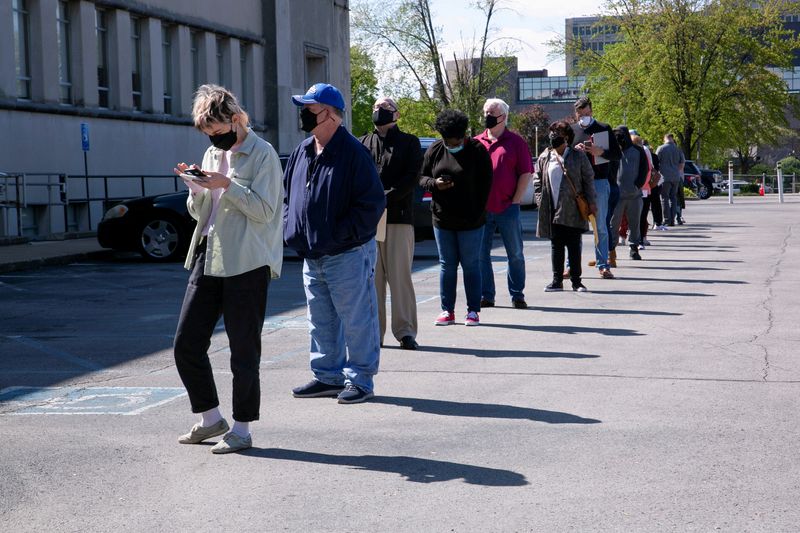By Lucia Mutikani
WASHINGTON (Reuters) - The number of Americans filing new claims for unemployment benefits dropped to their lowest level this year last week, while layoffs declined sharply in February, indicating that the labor market recovery was gaining steam.
But the upbeat labor market outlook was overshadowed by a survey on Thursday showing services industry activity slowed for a third straight month in February, with a measure of employment in the sector contracting for the first time since June 2021.
According to the Institute for Supply Management (ISM), services businesses reported they were "having significant issues with hiring both full time and contract labor," and that "open positions are not being filled, and candidates are looking for more money." Employment growth at factories also slowed last month, which poses a downside risk to job gains in February.
There were a near record 10.9 million job openings at the end of December. Economists are expecting the government's closely watched employment report on Friday will show another month of solid job growth, with the Omicron COVID-19 variant wave of infections significantly diminished.
"Workers leaving for better-paying jobs and more flexible conditions are annoying for employers, but the churn is neutral for employment on net as long as the workers find a job that satisfies their needs," said Will Compernolle, a senior economist at FHN Financial in New York. "The contraction is not encouraging, but lingering Omicron effects could have spilled into February."
Initial claims for state unemployment benefits dropped 18,000 to a seasonally adjusted 215,000 for the week ended Feb. 26, the lowest level since Jan. 1 and the second straight weekly drop, the Labor Department said. Economists polled by Reuters had forecast 225,000 applications.
Unadjusted claims declined 21,285 to 194,693 last week, led by big decreases in California and Michigan, which offset a jump in filings in Massachusetts and Rhode Island.
Claims could soon fall back below 200,000, a level they were last below in early December. Claims have plunged from a record high of 6.149 million in early April 2020. The number of people receiving benefits after an initial week of aid edged up 2,000 to 1.476 million during the week ended Feb. 19.
Tight labor market conditions are fueling wage growth, which is adding to inflation pressures.
Federal Reserve Chair Jerome Powell told lawmakers on Wednesday that "the labor market is extremely tight."
Powell said he would support a 25-basis-point interest rate hike at the U.S. central bank's March 15-16 policy meeting and would be "prepared to move more aggressively" if inflation does not abate as fast as expected.
Stocks on Wall Street were mostly higher. The dollar rose against a basket of currencies. U.S. Treasury yields fell.
LAYOFFS TUMBLE
The ISM said on Thursday its non-manufacturing activity index fell to 56.5 in February, the lowest in a year, from 59.9 in January.
The third straight monthly decline in the index was despite coronavirus cases decreasing substantially from mid-January. A reading above 50 indicates growth in the services sector, which accounts for more than two-thirds of U.S. economic activity.
The bulk of the survey was likely conducted before Russia started its war against Ukraine last week, which has boosted prices of oil, wheat and other commodities.
The ISM said supply chain disruptions, capacity constraints, inflation, logistical challenges and labor shortages were affecting services businesses' ability "to meet demand, leading to a cooling in business activity and economic growth."
Inflation and supply constraints could worsen because of the Russia-Ukraine conflict.
"Though Europe will bear the brunt of the economic cost of the Russia-Ukraine crisis, unfavorable geopolitics in the continent threaten to exacerbate supply issues and price pressures for the U.S. services sector," said Bernard Yaros, an economist at Moody's (NYSE:MCO) Analytics in West Chester, Pennsylvania.
"There will be disruptions to the transportation and logistics industries, many flights have been canceled or rerouted, leading to increased pressure on cargo capacity."
The survey's services industry employment gauge dropped to a 1-1/2-year low of 48.5 from 52.3 in January. It was the first contraction in the index since June 2021. Some companies in the professional, scientific and technical services industry declared that the "Great Resignation is real."
Economists at Wells Fargo (NYSE:WFC) lowered their February payrolls forecast to 375,000 from 450,000 earlier.
According to a Reuters survey of economists, nonfarm payrolls likely increased by 400,000 jobs in February after rising 467,000 in January. The unemployment rate is forecast to fall to 3.9% from 4.0% in January.

Hopes for a solid employment report were supported by a third report from global outplacement firm Challenger, Gray & Christmas showing U.S.-based employers announced 15,245 job cuts in February, down 20% from January.
Companies also announced plans to hire 215,127 workers last month, the largest February total since Challenger began tracking monthly hiring figures in 2002. That compared to the 77,630 jobs announced in January.
